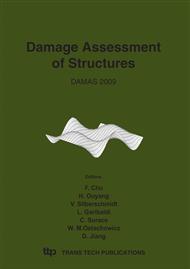p.31
p.39
p.47
p.55
p.63
p.71
p.79
p.87
p.95
Identification of Small Crack in Beam Structures Using Anti-Resonant Frequency and Wavelet Analysis
Abstract:
Structural crack identification has been received considerable attention in recent decade. A lot of different techniques like acoustic emission, ultrasonic, or X-ray, etc have been used for structural crack detection. However, it is still difficult to identify the small crack in structures. A new method for identification of small crack in beam structures using the first anti-resonant frequency curve is proposed in this paper. The method makes use of the driving-point mechanical impedance characteristics of beam structures and a simplified rotational spring model to model the edge crack of beam. After the first anti-resonant frequency curve is obtained, signal process based on wavelet transformation will be carried out and the small crack in beam structures can be explored. The proposed method is validated by a numerical example of cracked beam with pinned-pinned or fixed-free boundary. It is concluded that not only the location of beam crack can be determined, but also the extent of crack damage can be identified qualitatively based on the first anti-resonant frequency curve and wavelet analysis.
Info:
Periodical:
Pages:
63-70
Citation:
Online since:
June 2009
Authors:
Price:
Сopyright:
© 2009 Trans Tech Publications Ltd. All Rights Reserved
Share:
Citation:


